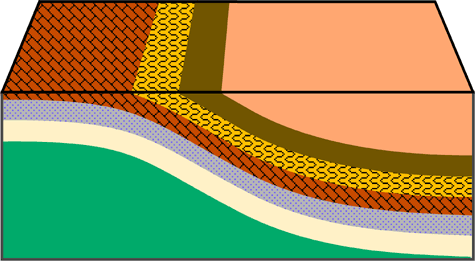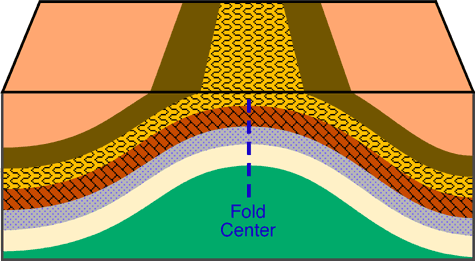Yahoola's Bent Rock Earthcache EarthCache
Yahoola's Bent Rock Earthcache
-
Difficulty:
-

-
Terrain:
-

Size:  (other)
(other)
Please note Use of geocaching.com services is subject to the terms and conditions
in our disclaimer.
You can expect a short walk to this Earthcache from the parking coordinates. Cross the bridge and follow the hiking trail downstream. The trail will get smaller as you go and will be slick at one short downhill section. You will have to negotiate a very small stream at the bottom of the small downhill. You are in a North Georgia wooded and water environment. That means watch for snakes near the water. Have Fun!!
At the posted coordinates you will find a very large granite outcrop going up the hillside. You should see a strange pattern of cracks along the side that is visible from the coordinates. Below you will find geological information relating to the region and this particular phenomena.
The granite seen in front of you formed millions of years ago. It is the result of cooling magma deep inside the earth's crust. The combination of uplift and erosion has brought this formation to the surface.
The southern Appalachian Mountains are comprised of this rock as well as many others. At the time they formed, the Appalachians were much higher than they are today -- more like the present-day Rocky Mountains. While the Atlantic Ocean was still in its infancy, the Appalachians were already being attacked by erosion. For the last 100 million years, erosion has carved away the mountains, leaving only their cores standing. Erosion continues today and is constantly altering the landscape of the Southern Appalachians.
Geological Folds
Deformation of rock involves changes in the shape and/or volume of these substances. Changes in shape and volume occur when stress and strain causes rock to buckle and fracture or crumple into folds. A fold can be defined as a bend in rock that is the response to compressional forces. Folds are most visible in rocks that contain layering. For plastic deformation of rock to occur a number of conditions must be met, including:
The rock material must have the ability to deform under pressure and heat.
The higher the temperature of the rock the more plastic it becomes.
Pressure must not exceed the internal strength of the rock. If it does, fracturing occurs.
Deformation must be applied slowly.
A number of different folds have been recognized and classified by geologists. The simplest type of fold is called a monocline. This fold involves a slight bend in otherwise parallel layers of rock.

An anticline is a convex up fold in rock that resembles an arch like structure with the rock beds (or limbs) dipping way from the center of the structure. Note how the rock layers dip away from the center of the fold are roughly symmetrical.

A syncline is a fold where the rock layers are warped downward. Both anticlines and synclines are the result of compressional stress. Note how the rock layers dip toward the center of the fold and are roughly symmetrical.

More complex fold types can develop in situations where lateral pressures become greater. The greater pressure results in anticlines and synclines that are inclined and asymmetrical.
A recumbent fold develops if the center of the fold moves from being once vertical to a horizontal position. Recumbent folds are commonly found in the core of mountain ranges and indicate that compression and/or shear forces were stronger in one direction. Extreme stress and pressure can sometimes cause the rocks to shear along a plane of weakness creating a fault.

NOTE: To claim credit for this Earthcache you must email me the answers to the following questions. If you do NOT send the email on the SAME day, your log will be deleted! You may include a photo on the cache page but it is not required.
Question 1 - Estimate the size of the rock formation.
Question 2 - Describe the bent rock from left to right from the posted coordinates (ie. does it go up, down, up then down, down then up, etc.)
Question 3 - From reading the text above, is Yahoola's bent rock a geological fold?
Question 4 - If yes, what type of fold is it? AND, how was it created? If no, what in your opinion is responsible for the bent rock appearance of the outcrop?
Congrats FTF - Ent of Spades and davidandbritt
Additional Hints
(No hints available.)